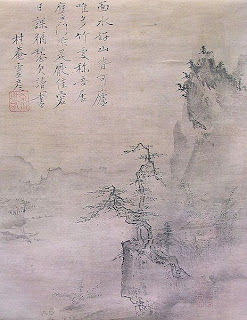I feel like I've been getting too riled up on this last couple sessions, and because of that I haven't been able to paint well both techinically and in the spirit of sumi. So I've decided to use this session to expain a little bit of history and to take another look at a famous sumi master.
Sumi history extends thousands of years in the past. Now I won't go too much into detail on how it evolved step by step, but one of the largest influences to sumi was Buddhism. In Japan, the art-form was practiced by monks and samurai as a way of calming the mind. They would spend time before painting to meditate, and the preparing of the inkstone and the brush was part of this meditation too. For me, I'm using this blog post and history lesson as meditation for my final piece. All this preparation and philosophy went into the process. For samurai, the brush was symbolic of the sword and practicing sumi taught them how to remain calm and collected. Nowadays, although the samurai are gone the art-form of sumi persists.

This brings me to my next subject which is Sesshu Toyo, a famous master sumi painter. He is most famous for his landscapes such as the one shown above which is entitled View of Ama-no-Hashidate. Considering the work that I've done, I can hardly imagine the time a

nd concentration it must have taken to paint something so large and detailed. The reason I picked Sesshu Toyo as an artist for me to look at was that he has this piece, Haboku-Sansui, shown to the left. It is remarkably different from the painting shown above, but is just as beautiful and elegant. I am using Toyo to find inspiration in using sumi in a way I had not thought of. His "splash-ink" style to the left is one subject that interests me. I believe I will be ready to do something good for the next session.













